 |
||||||||||
These are superconducting characters.
(1) Electrical resistance = 0 Ω ( Existence of eternal current)
(4) Type-I and Type-II superconductors
(6) Creating electric pair (Cooper pair) and energy gap near EF
(1) Electrical resistance = 0 Ω (Existence of eternal current)
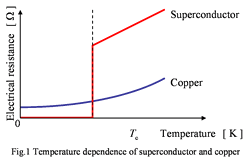 Copper wire is most often used by home conducting wire. This reason is that the copper’s resistance is very low. However, copper even has electrical resistance in the case of diameter = 1 mm and length 100 m wire. If current is flow electrical line which was made copper wire to long distance, this resistance can not avoid. In superconducting state, electrical resistance is equal to zero. So superconductor can flow current eternally. If we can make superconducting electrical line, we can flow large amount of current without less of one. Electrical resistance = 0 in superconductors is the most attention of superconducting state.
Copper wire is most often used by home conducting wire. This reason is that the copper’s resistance is very low. However, copper even has electrical resistance in the case of diameter = 1 mm and length 100 m wire. If current is flow electrical line which was made copper wire to long distance, this resistance can not avoid. In superconducting state, electrical resistance is equal to zero. So superconductor can flow current eternally. If we can make superconducting electrical line, we can flow large amount of current without less of one. Electrical resistance = 0 in superconductors is the most attention of superconducting state.
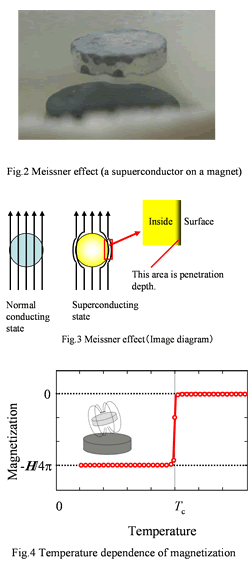 If we get up magnet to superconductors, we can notice strong repulsion despite magnetic pole (In fig.3, lower black material is superconductor. Floating material is magnet). This behavior is Meissner effect (perfect diamagnetism) having superconducting materials. Meissner effect is that the magnetic flux can not invent into superconductor. This phenomena was discovered by W. Meissner and R. Ochsenfeld in 1933.
Figure.4 shows schematic diagram of Meissner effect. When we applied magnetic flux to superconducting material after cooling temperature above Tc, magnetic flux reject in superconductor. Moreover, when we applied magnetic flux to normal conducting state of superconducting material, the magnetic flux which pass through superconducting material are also rejected in superconductor after cooling under Tc. The magnetic flux can not invent superconductor, because shielding current flow to surface of superconductor. As the superconducting state in applied magnetic field, this current flows the area of 1 m depth from superconductor's surface. And this current induce counter magnetic field against applied one. This mechanism prevent from inventing magnetic flux into superconductor (Area in which shielding current flow is normal conducting state. However, this area rapid decreases toward inside of superconductor. This area is called penetration depth: λ.
Meisnner effect is particular properties of superconductivity and necessary matters to be determined superconductor as same as zero resistance.
In order to confirm Meissner effect, we measure temperature dependence of magnetization in applied magnetic field: H . The magnetic flux density is associated by B = H + 4πM. Here, M is magnetization and H is the applied magnetic field. Moreover, M is associated to M = γH among magnetic susceptibility: γ. B is expressed to B = H+4πM = H+4πγH. In inside of superconductor, M = -H/4π is realized because magnetic flux density is equal to zero. Consequently, as we measure temperature dependence of magnetization, magnetization value discontinuity changes M = -H/4π at just Tc (Fig.5). This behavior is called perfect diamagnetism.
If we get up magnet to superconductors, we can notice strong repulsion despite magnetic pole (In fig.3, lower black material is superconductor. Floating material is magnet). This behavior is Meissner effect (perfect diamagnetism) having superconducting materials. Meissner effect is that the magnetic flux can not invent into superconductor. This phenomena was discovered by W. Meissner and R. Ochsenfeld in 1933.
Figure.4 shows schematic diagram of Meissner effect. When we applied magnetic flux to superconducting material after cooling temperature above Tc, magnetic flux reject in superconductor. Moreover, when we applied magnetic flux to normal conducting state of superconducting material, the magnetic flux which pass through superconducting material are also rejected in superconductor after cooling under Tc. The magnetic flux can not invent superconductor, because shielding current flow to surface of superconductor. As the superconducting state in applied magnetic field, this current flows the area of 1 m depth from superconductor's surface. And this current induce counter magnetic field against applied one. This mechanism prevent from inventing magnetic flux into superconductor (Area in which shielding current flow is normal conducting state. However, this area rapid decreases toward inside of superconductor. This area is called penetration depth: λ.
Meisnner effect is particular properties of superconductivity and necessary matters to be determined superconductor as same as zero resistance.
In order to confirm Meissner effect, we measure temperature dependence of magnetization in applied magnetic field: H . The magnetic flux density is associated by B = H + 4πM. Here, M is magnetization and H is the applied magnetic field. Moreover, M is associated to M = γH among magnetic susceptibility: γ. B is expressed to B = H+4πM = H+4πγH. In inside of superconductor, M = -H/4π is realized because magnetic flux density is equal to zero. Consequently, as we measure temperature dependence of magnetization, magnetization value discontinuity changes M = -H/4π at just Tc (Fig.5). This behavior is called perfect diamagnetism.
(3)Existence of critical temperature (Tc), critical magnetic field (Hc) and critical current density (Jc)
Superconductor has three-type of critical point (critical value).
- Critical Temperature: Tc
- Critical magnetic field: Hc
- Critical current density: Jc
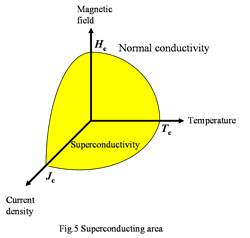 Superconductivity state only exist in surrounding three critical poing area (yellow color area in fig.6). If we flow large amount of current to superconductor, we must increase Jc. However, if Jc is very large, magnetic field induced by Jc is also large. So, in this case, we must increase Jc and Hc values in superconductivity. As we make efficient use of superconductor, it is important to increase these critical values. However, the most maximum priority of developing new superconductor is to discovery more high Tc material (Hc and Jc can enhance these values to change synthesis methods or conditions.).
Superconductivity state only exist in surrounding three critical poing area (yellow color area in fig.6). If we flow large amount of current to superconductor, we must increase Jc. However, if Jc is very large, magnetic field induced by Jc is also large. So, in this case, we must increase Jc and Hc values in superconductivity. As we make efficient use of superconductor, it is important to increase these critical values. However, the most maximum priority of developing new superconductor is to discovery more high Tc material (Hc and Jc can enhance these values to change synthesis methods or conditions.).
(4)Type-I and Type-II superconductors
In superconductors, there are two kind of superconductors from difference of magnetic behavior. Large difference is behavior against increasing applied magnetic field. Fig.7 shows difference between Type-I and Type-II superconductor (Fig.7 shows superconductor’s condition in increasing applied magnetic field (upper figure) and magnetic field dependence of magnetization at that magnetic field (lower figure) in each Type-I (a) and Type-II (b) superconductors ). Type-I superconductor shows perfect diamagnetism (Miessner diamagnetism) under critical magnetic field: Hc. However superconductivity state lost at Hc. Almost element superconductors are Type-I. On the other hand, Type-II superconductor shows perfect diamagnetism at some applied magnetic fields as same as Type-I. As applied magnetic field reaches lower critical field: Hc1, the magnetization which induced superconductor decreases. And as applied magnetic field increase more strongly to upper critical field: Hc2, the magnetization makes the transition to zero and normal conducting state continuously. There are coexistence state superconducting area and magnetic field which is called quantum flux between Hc1 and Hc2 area. This area is called mixing state (coexistence condition). This condition is not Miessner diamagnetism state. However superconducting state is kept. In order to keeping superconducting state, superconductors necessary some energy to reject magnetic field. Type-I superconductor shows perfect diamagnetism and increase these diamagnetic values in lower magnetic field. And superconducting state finally brakes at Hc because superconductivity can not resist some energy of rejecting magnetic fields. Type-II superconductor is not resisting magnetic field but allowing to invent some magnetic flux. Consequently, Type-II superconductor alleviates necessary energy of rejecting magnetic field (energy for keeping perfect diamagnetism) by inventing some magnetic flux. In Type-II superconductor, Tc, Hc and Jc values are very large comparison in Type-I superconductor.
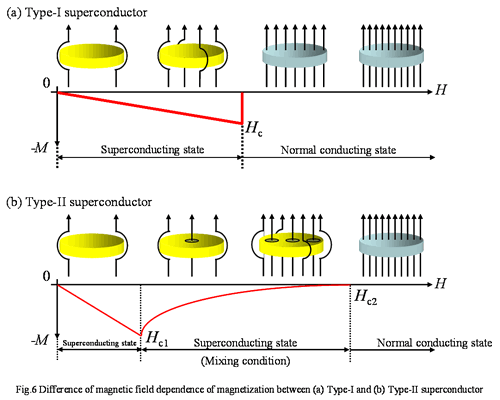
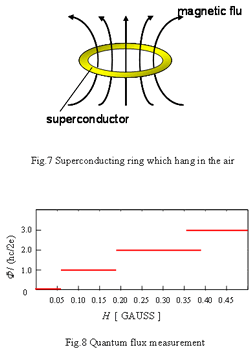 This phenomena was discovered by B. S. Deaver and W. M. Fairbank group[3] and R. Doll and M. Nahbauer group[4]in 1961. They performed measuring magnetic flux pass through the superconducting ring which hang in the air. As the results, they discovered that the magnetic flux which pass through the superconducting ring were not having continuous values but only having integral multiple values of unit quantum flux: Φ0. Consequently, Φ is related to this formula.
This relation is called quantum flux. And Φ0 is called fluxoid.As Φ is expressed quantum numbers, it shows that current which flows to surface of superconducting ring (superconducting current induced by electromagnetic induction) is adjusted reasonably. Essentially, current is caused by flowing large number of electrons. So, current has continuous values. In superconductivity state, we can confirm "Quantization in macro scale". This is essential of superconducting state.
This phenomena was discovered by B. S. Deaver and W. M. Fairbank group[3] and R. Doll and M. Nahbauer group[4]in 1961. They performed measuring magnetic flux pass through the superconducting ring which hang in the air. As the results, they discovered that the magnetic flux which pass through the superconducting ring were not having continuous values but only having integral multiple values of unit quantum flux: Φ0. Consequently, Φ is related to this formula.
This relation is called quantum flux. And Φ0 is called fluxoid.As Φ is expressed quantum numbers, it shows that current which flows to surface of superconducting ring (superconducting current induced by electromagnetic induction) is adjusted reasonably. Essentially, current is caused by flowing large number of electrons. So, current has continuous values. In superconductivity state, we can confirm "Quantization in macro scale". This is essential of superconducting state.
(6)Creating electric pair (Cooper pair) and energy gap near EF
The most feature of superconductor in electron state is energy gap (superconducting gap) like Fig.10(b) near the Fermi energy: EF. Energy gap is the area that the electron can not exist. Therefore, some energy are necessary in order to exiting superconducting electrons above EF level. In this section, we see electron state of superconductivity and superconducting mechanism comparison normal metal’s electron state. In normal metal, large number of electrons move freedom (1022~1023 electron/cm3, maximum velocity: 1000 km/s). It is difficult to image this movement. However, the electron in the solid is confined own allowing movement by some role. Moreover there are two kind of electron being distinguished by orientation of own spin. So, electron also is confined by Pauli exclusion principle. As the results, large amount of electrons is changed separate state. Each electron occupy energy band in order of increasing lower momentum like Fig.10. And at the absolute zero, all electron occupied under some energy. This energy is called Fermi energy: EF (EF ~ 10000 ℃). And this energy level is called Fermi level. The electron belong to Fermi particle. In Fermi particle all particle is constrained by some rule and create Fermi level (On the other hand, there is particle which is not constrained and can occupy same energy level without limit. This particle is called Bose particle. So, Bose particles occupy lowest energy level all together.). In finite temperature range, the electron occupied under EF is exited to non-occupied energy level above EF by thermal energy in system. This condition is normal conductor’s electron state, such as the metal.

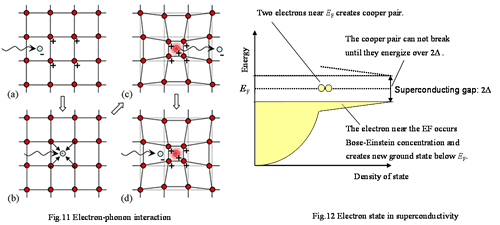
(7) Isotopic effect
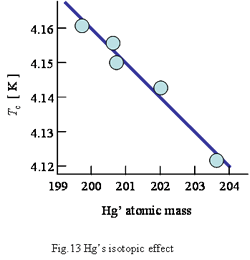 The superconductivity is seemed to consider to electron conducting phenomena. However, it is caused by interaction between the electron and lattice vibration, such as electron-phonon interaction. Isotopic effect is evidence that lattice vibration is associated with superconductivity state. Isotopic effect is phenomena of changing Tc against atomic mass. Most famous experiment is Hg’s isotopic effect discovered by E. Maxwell and C. A. Reynolds (in 1950’s year) in Fig.14. From these result, Tc was related to atomic mass.
Lattice vibration was considered to disturb electrical conductivity. After discovery of isotopic effect, we began to consider that lattice vibration is related to superconducting state. As the result, electron-phonon interaction was discovered.Over 2000 kind of superconductor is discovered up to date. It is said that copper-oxides having 100 K class Tc don’t have isotopic effect by many experimental results. From this result, they are considered that superconductivity in copper-oxides has unconventional superconducting mechanism which different from electron-phonon interaction. Isotopic effect is known powerful experimental method to resolve superconducting mechanism.
The superconductivity is seemed to consider to electron conducting phenomena. However, it is caused by interaction between the electron and lattice vibration, such as electron-phonon interaction. Isotopic effect is evidence that lattice vibration is associated with superconductivity state. Isotopic effect is phenomena of changing Tc against atomic mass. Most famous experiment is Hg’s isotopic effect discovered by E. Maxwell and C. A. Reynolds (in 1950’s year) in Fig.14. From these result, Tc was related to atomic mass.
Lattice vibration was considered to disturb electrical conductivity. After discovery of isotopic effect, we began to consider that lattice vibration is related to superconducting state. As the result, electron-phonon interaction was discovered.Over 2000 kind of superconductor is discovered up to date. It is said that copper-oxides having 100 K class Tc don’t have isotopic effect by many experimental results. From this result, they are considered that superconductivity in copper-oxides has unconventional superconducting mechanism which different from electron-phonon interaction. Isotopic effect is known powerful experimental method to resolve superconducting mechanism.
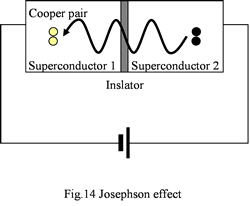 Josephson effect was discovered by B. D. Josephson in 1962. This is tunnel effect in superconductivity. The tunnel effect is phenomena that the electron conducts thin insulator film between two metal plate by adding voltage to metal plate. This phenomena is famous experiment showing 「wave character of quantum」 in quantum mechanics And this current is called tunnel current. After the discovering experimental result of Josephson effect, we generally considered that the tunnel effect didn’t occur in superconductor. Even if ratio of conducting insulator thin film of one electron is very low, we considered that it is impossible that cooper pair occur tunnel effect in superconducting state. However, as the result of tunnel effect experiments in superconductor-insulator-superconductor junction (SIS junction), we checked that electron pair (cooper pair) pass thorough insulator film in superconducting state (Fig.15).In SIS junction, tunnel current flows in applied voltage = 0 (Direct-Current Josephson effect). Moreover, as the voltage added to SIS junction, we discovered that across current flows in this junction (Alternating-Current Josephson effect). These phenomena are caused by difference of wave function's phase between superconductors.
Josephson effect was discovered by B. D. Josephson in 1962. This is tunnel effect in superconductivity. The tunnel effect is phenomena that the electron conducts thin insulator film between two metal plate by adding voltage to metal plate. This phenomena is famous experiment showing 「wave character of quantum」 in quantum mechanics And this current is called tunnel current. After the discovering experimental result of Josephson effect, we generally considered that the tunnel effect didn’t occur in superconductor. Even if ratio of conducting insulator thin film of one electron is very low, we considered that it is impossible that cooper pair occur tunnel effect in superconducting state. However, as the result of tunnel effect experiments in superconductor-insulator-superconductor junction (SIS junction), we checked that electron pair (cooper pair) pass thorough insulator film in superconducting state (Fig.15).In SIS junction, tunnel current flows in applied voltage = 0 (Direct-Current Josephson effect). Moreover, as the voltage added to SIS junction, we discovered that across current flows in this junction (Alternating-Current Josephson effect). These phenomena are caused by difference of wave function's phase between superconductors.
[1] W. Meissner and R. Ochsenfeld Naturewissen, 21 (1933) 787
[2] B. D. Josephson Phy. Rev. Lett, 1 (1962) 251
[3] B. S. Deaver and W. M. Fairbank Phy. Rev. Lett, 7 (1961) 4
[4] R. Doll and M. Nabauer Phy. Rev. Lett, 7 (1961) 51
[5] J. Bardeen, L. N. Cooper and J. R. Schrierfer Phys. Rev, 108 (1957) 1175
[6] H. Frolich Phys. Rev, 79 (1950) 845
[7] L. N. Cooper Phys. Rev, 104 (1956) 1189
